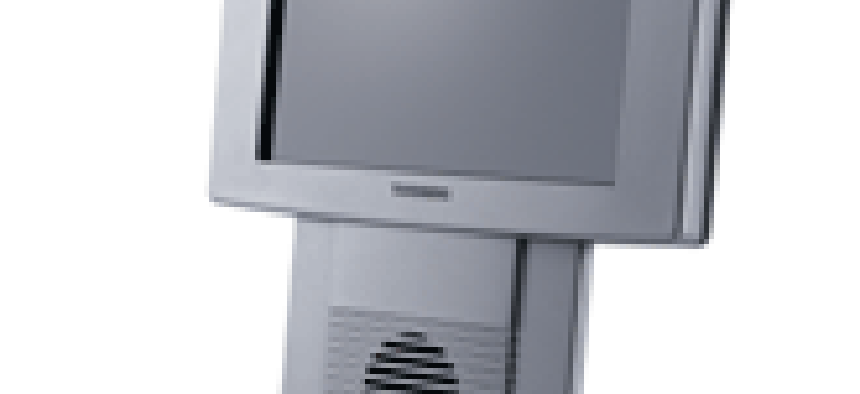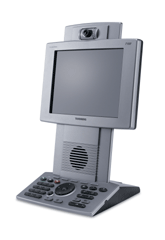To believe a certain series of television commercials designed to promote a 'videoconference phone,' setting up a full-blown videoconference is about as easy as planning a trip to Neptune. But in fact, the same IP communications that let a telephone-maker add a conferencing feature is letting mainstream videoconferencing companies put their systems within easy reach.Whether because users have travel restrictions, need to be in too many places in a single day, or just want more face-to-face communication, videoconferencing equipment is selling. And desktop configurations are proving to be as popular as the big box for conference rooms, according to people in the industry.'A year and a half, two years ago, [this was] more of a box space,' said Barry Morris, vice president of federal systems for Polycom Inc. of Pleasanton, Calif. That involved setting up a conference room or unified bridge for the larger conference areas. Now, videoconferencing is more of an end-to-end process, he said.Morris credited government leaders such as former Defense Department executive Dawn Meyerriecks for changing the videoconference model from pushing information down to users to pulling data in from the field and then disseminating it. It means making video available on a variety of connections, even cell phones, Morris said, and it will ultimately mean more of a shift from Integrated Services Digital Network lines to IP-based communications.Today, Morris said, 'about 60 percent [of videoconferencing] is done via ISDN, [and] about 40 percent over IP. In about two years, that's going to flip, even [in about] 18 months. Every single major service has initiatives to start moving towards IP.'On the civilian side, the gradual move toward telecommuting could also make desktop videoconferencing more important. Audio conference calls, Morris claimed, re-sult in a 40 percent information retention rate; video ups that to between 60 and 65 percent.Dan Brigati, vice president of federal sales for Tandberg of New York, isn't ready to write off the big-room systems just yet but agrees that IP is where things are heading, aided by a growing interest in using voice over IP.The migration to IP networks, Brigati said, is 'a huge thing that's affecting video. VOIP is very, very hot; [there are] a lot of companies that came out with a viable solution, not only IP voice, but also video.'Along with IP, other technological ad- vances have made videoconferencing more attractive and affordable, Brigati said.'Some of the new standards have provided incredible technology,' he said, noting that the impact of the ITU-T H.264 digital video standard 'is analogous to what color TV did for the [broadcast] television industry.'Brigati said that, overall, 'improvements are just phenomenal,' such as moving from CRT television tubes to flat-screen LCD and plasma displays with 'much higher resolution and better quality.'And prices are coming down, he said. A turnkey room system once cost between $50,000 and $60,000; 'now there are systems from $2,000 to $30,000 or $40,000; there are so many options available,' he said.Those options range from desktop to conference room systems, but all include some basic features.Security becomes vital when you consider the amount of videoconferencing DOD and the intelligence community use.'Government people for years have bought into the mission-critical aspects of visually communicating. So at the command level, particularly in the DOD environment and the [intelligence] world, it's the only way they would communicate. Versus an audio conference, there's just no alternative for them,' Brigati said.Moving away from a 'box mentality' to an end-to-end solution is becoming important for many agencies, Morris said. The Air Force and the Defense Information Systems Agency 'are big proponents of convergence. The good news is that a lot of the major organizations are starting to understand [the] need for doing more with less, getting a better return on investment, and want to figure out a way of getting information into [the] right hands,' he said.Much of that will involve video from the desktop, where small cameras are already sprouting. Integrated with its $200-per-seat proprietary software, Polycom's PVX product turns that camera 'into a full-blown collaborative solution,' according to Morris.Other vendors are wagering that such a market exists: Last June, Sony rolled out the PCS-TL50, a 20-inch, $4,995 LCD-based product that includes a built-in pan-tilt-zoom video camera, microphone and video codec. It doubles as a PC monitor, albeit one that commands a price premium for its extra features.Where should buyers begin when looking at videoconferencing systems for an office or an entire agency?'Start with how you're going to provide the video, schedule it, manage it and configure it so that it works well every time,' Tandberg's Brigati said. It's also important to determine what the video system will be used for'management meetings, office collaboration or other purposes.Polycom's Morris says users should 'move away from a box mentality to an end-to-end mentality, encompassing all the needs an agency has, whether it's voice, data or video.'And, according to Brigati, agencies should be ready to take videoconferencing outside their walls where appropriate, to the wider, public-network world.'Videoconferencing for years has been an internal technology because there's no directory structure to understand who's got video today,' he said. 'We've introduced a technology, called Expressways, that allows you to domain-name-dial across the public Internet. Now it enables you to get closer to your customers and work with your supply chain,' he said.At the same time, Brigati noted, public-network quality is very good. 'Ninety percent of my conferences are over the public Internet, and the quality is great,' he said.
Talk securely: Tandberg's 150 MXP all-in-one desktop system has security features such as password protected administration.







